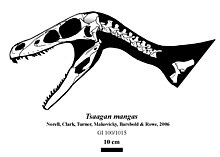Tsaagan
| Tsaagan | |
|---|---|

| |
| Holotype skull | |
| Scientific classification | |
| Domain: | Eukaryota |
| Kingdom: | Animalia |
| Phylum: | Chordata |
| Clade: | Dinosauria |
| Clade: | Saurischia |
| Clade: | Theropoda |
| Family: | †Dromaeosauridae |
| Clade: | †Eudromaeosauria |
| Subfamily: | †Velociraptorinae |
| Genus: | †Tsaagan Norell et al., 2006 |
| Species: | †T. mangas
|
| Binomial name | |
| †Tsaagan mangas Norell et al., 2006
| |
Tsaagan (meaning "white") is a
Discovery and naming

The holotype of Tsaagan was discovered in 1996 and first identified as a specimen of
The holotype specimen, IGM 100/1015, was found near Xanadu in Ömnögovi Province in layers of the Djadokhta Formation dating to the Campanian, about 75 million years ago. It consists of a well-preserved skull and series of ten neck vertebrae as well as a damaged left shoulder girdle. It is the only specimen found of Tsaagan and belonged to an adult individual.[1]
Description

Tsaagan was a medium-sized dromaeosaurid. In 2010
Classification
Tsaagan is a member of the group
Below are the results for the Eudromaeosauria
| Eudromaeosauria |
| |||||||||||||||||||||||||||||||||||||||||||||||||||||||||||||||
Paleoenvironment
Tsaagan represents the only dromaeosaurid remains (other than isolated teeth) known from the
See also
References
- ^ hdl:2246/5823.
- ^ Paul, G.S., 2010, The Princeton Field Guide to Dinosaurs, Princeton University Press p. 137
- ^ Xu X, Choinere J, Pittman M, Tan Q, Xiao D, Li Z, Tan L, Clark J, Norell M, Hone DW, Sullivan C (19 March 2010). "A new dromaeosaurid (Dinosauria: Theropoda) from the Upper Cretaceous Wulansuhai Formation of Inner Mongolia, China" (PDF). Zootaxa (2403): 1–9. Retrieved 2010-03-19.
- PMID 21726330.
- S2CID 83572446.
- ^ Xu Xing; Michael Pittman; Corwin Sullivan; Jonah N. Choiniere; Qing Wei Tan; James M. Clark; Mark A. Norell; Wang Shuo (2015). "The taxonomic status of the Late Cretaceous dromaeosaurid Linheraptor exquisitus and its implications for dromaeosaurid systematics". Vertebrata PalAsiatica. 53 (1): 29–62.
- S2CID 202002676.
